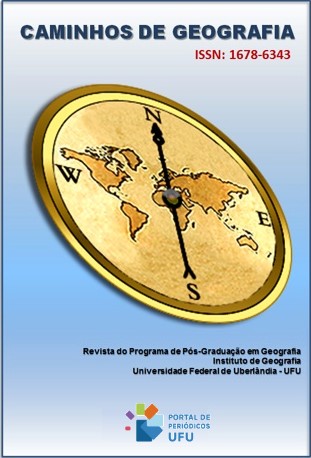DISTRIBUIÇÃO ESPACIAL E TEMPORAL DE GEADAS NO RIO GRANDE DO SUL ENTRE 2003-2018
DOI:
https://doi.org/10.14393/RCG2510171617Palavras-chave:
Ocorrência de geadas, Regiões ecoclimáticas do RS, Estações do ano, Intensidade de geadaResumo
A geada é um fenômeno meteorológico frequente no estado do Rio Grande do Sul (RS), que causa impactos negativos na produção agropecuária. O objetivo deste trabalho foi caracterizar a distribuição espacial e temporal de geadas no RS por meio de dados (data de ocorrência e intensidade) do Instituto Nacional de Meteorologia (INMET) dos municípios de Bagé, Uruguaiana, Bom Jesus, Caxias do Sul, Passo Fundo, São Luiz Gonzaga, Santa Maria e Santa Vitória do Palmar, de março a novembro na série 2003 a 2018. No período ocorreram, no total, 1.712 geadas, com média de 107 por ano e variação anual entre 58 (2017) a 161 (2007). Espacialmente, variou de 6,5% (São Luiz Gonzaga) a 20,4% (Bom Jesus), com maiores registros no inverno (81%), seguido do outono (13%) e primavera (6%). Em todos os anos, com exceção de 2010, e locais (exceto Uruguaiana) apresentaram maior ocorrência de geadas precoces (outono). Quanto à intensidade, 47% das geadas ocorridas no período foram fracas, 24% moderadas e 29% fortes. A maior possibilidade de ocorrências de geadas foi para Bom Jesus (211 dias com 90% de possibilidade) e a menor foi para Uruguaiana (108 dias).
Downloads
Downloads
Publicado
Edição
Seção
Licença
Copyright (c) 2024 Ivonete Fatima Tazzo, Gustavo Trentin, Loana Silveira Cardoso, Amanda Heemann Junges

Este trabalho está licenciado sob uma licença Creative Commons Attribution-NonCommercial-NoDerivatives 4.0 International License.
Autores que publicam nesta revista concordam com os seguintes termos: a) Autores mantém os direitos autorais e concedem à revista o direito de primeira publicação, com o trabalho licenciado sob a Creative Commons Atribuição-NãoComercial-SemDerivações 4.0 Internacional. b) Autores têm permissão e são estimulados a publicar e distribuir seu trabalho online (ex.: em repositórios institucionais ou na sua página pessoal), já que isso pode gerar alterações produtivas, bem como aumentar o impacto e a citação do trabalho publicado. c) Em virtude de aparecerem nesta revista de acesso público, os artigos são de uso gratuito, com atribuições próprias, em aplicações educacionais e não-comerciais.











